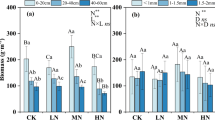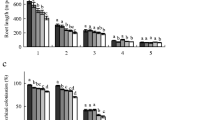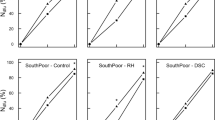Summary
Seedlings of red maple, white pine, pitch pine and red pine were fertilized with nutrient solutions containing 4 levels of nitrate or ammonium additions. These levels corresponded to approximately 0.5, 1, 2 and 4 times normal availability of nitrogen in northeastern forests. Nitrate reductase (NR) activity was assayed in roots and leaves. Red maples treated with nitrate showed much higher leaf activities and higher ratios of leaf NR activity to root NR activity than any other species. Ammonium additions to red maple and white pine appeared to inhibit NR activity in leaves. With high nitrate additions, NR activity was induced in roots and leaves of pine species, but activity in roots remained much higher than in leaves.
Similar content being viewed by others
References
Aber JD, Melillo JM, Nadelhoffer KJ, McClaugherty CA, Pastor J (1985) Fine root turnover in forest ecosystems in relation to quantity and form of nitrogen availability: a comparison of two methods. Oecologia 66: 317–321
Aber JD, Nadelhoffer KJ, Steudler P, Melillo JM (1989) Nitrogen saturation in northern forest ecosystems. BioScience 39: 378–386
Al Gharbi A, Hipkin CR (1984) Studies on nitrate reductase activity in British angiosperms. I. A comparison of nitrate reductase activity in ruderal, woodland-edge and woody species. New Phytol 97: 629–639
Beevers L, Hageman RH (1969) Nitrate reduction in higher plants. Annu Rev Plant Physiol 20: 495–522
Bigg WL, Daniel TW (1978) Effects of nitrate, ammonium and pH on the growth of conifer seedlings and their production of nitrate reductase. Plant Soil 50: 371–385
Burns RM, Honkala BH (1990a) Silvics of North America. 1. Conifers. Agriculture Handbook 654. U. S. Department of Agriculture, Forest Service, Washington, DC
Burns RM, Honkala BH (1990b) Silvics of North America. 2. Hardwoods. Agriculture Handbook 654. U. S. Department of Agriculture, Forest Service, Washington, DC
Campbell WH (1988) Nitrate reductase and its role in nitrate assimilation in plants. Physiol Plant 74: 214–219
Gutschick VP (1981) Evolved strategies in nitrogen acquisition by plants. Am Nat 118: 607–637
Haynes RJ, Goh KM (1978) Ammonium and nitrate nutrition of plants. Biol Rev 53: 465–510
Hewitt EJ (1966) Sand and water culture methods used in the study of plant nutrition. 2nd edn. Commonwealth Bureau of Horticultural and Plantation Crops. East Malling Tech Commun No 22. Commonwealth Agricultural Bureau, Farnham, England
Ho I, Trappe JM (1980) Nitrate reductase activity of nonmycorrhizal Douglas-fir rootlets and some associated mycorrhizal fungi. Plant Soil 54: 395–398
Jaworski EG (1971) Nitrate reductase assay in intact plant tissue. Biochem Biophys Res Commun 43: 1274–1279
Klepper L, Flesher D, Hageman RH (1971) Generation of reduced nicotinamide and dinucleotide for nitrate reduction in green leaves. Plant Physiol 48: 580–590
Krajina VJ, Madoc-Jones S, Mellor B (1973) Ammonium and nitrate in the nitrogen economy of some conifers growing in Douglas fir communities of the pacific northwest of America. Soil Biol Biochem 5: 143–147
Mengel K, Kirkby EA (1982) Principles of plant nutrition, 3rd edn. International Potash Institute, Bern, Switzerland
Nihlgard B (1985) The ammonium hypothesis — an additional explanation to the forest dieback in Europe. Ambio 14: 2–8
Pate JS (1973) Uptake assimilation and transport of nitrogen compounds by plants. Soil Biol Biochem 5: 109–119
Robertson GP (1982) Nitrification in forested ecosystems. Philos Trans R Soc Lond Ser B 296: 445–457
Schulze ED (1989) Air pollution and forest decline in a spruce (Picea abies) forest. Science 244: 776–783
Shaver GR, Melillo JM (1984) Nutrient budgets of marsh plants: efficiency concepts and relation to availability. Ecology 65: 1491–1510
Smirnoff N, Stewart GR (1985) Nitrate assimilation and translocation by higher plants: comparative physiology and ecological consequences. Physiol Plant 64: 133–140
Stewart GR, Hegarty EE, Specht RL (1988) Inorganic nitrogen assimilation in plants of Australian rainforest communities. Physiol Plant 74: 26–33
Woo KC, Jokinen M, Canvin DT (1980) Reduction of nitrate via a dicarboxylate shuttle in reconstituted system of supernatant and mitochondria from spinach leaves. Plant Physiol 65: 433–436
Author information
Authors and Affiliations
Rights and permissions
About this article
Cite this article
Downs, M.R., Nadelhoffer, K.J., Melillo, J.M. et al. Foliar and fine root nitrate reductase activity in seedlings of four forest tree species in relation to nitrogen availability. Trees 7, 233–236 (1993). https://doi.org/10.1007/BF00202079
Received:
Issue Date:
DOI: https://doi.org/10.1007/BF00202079




